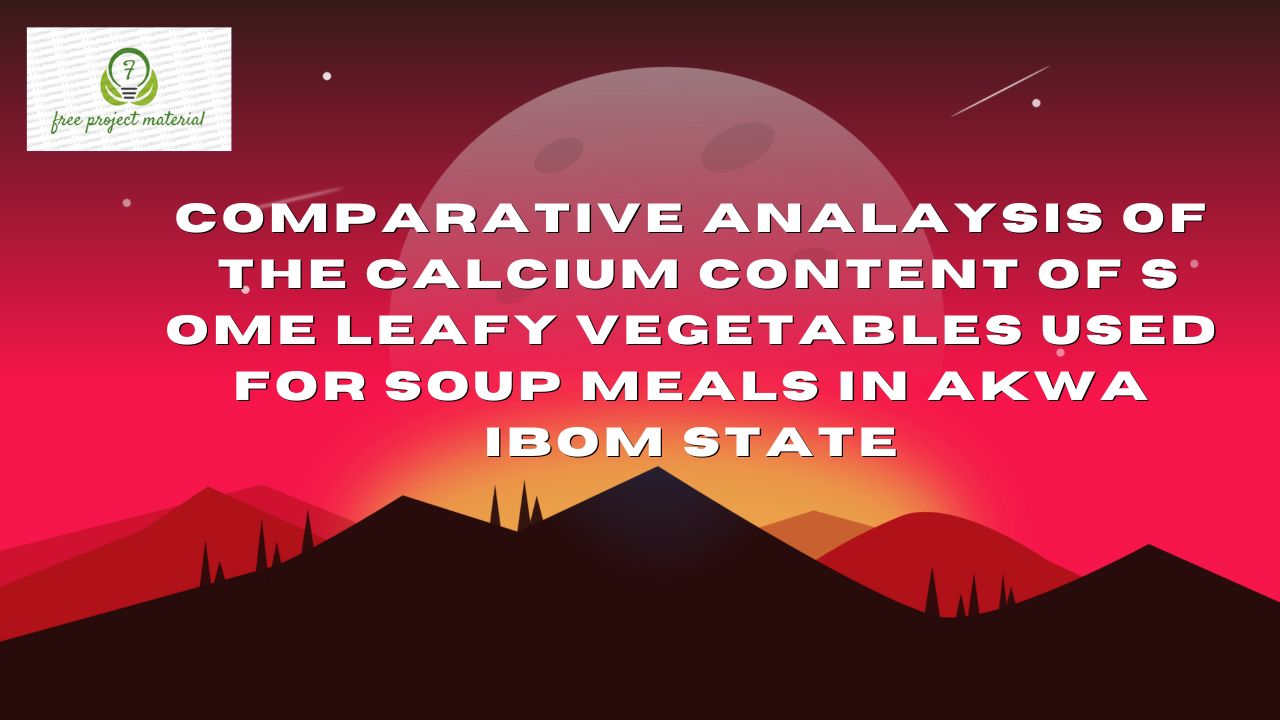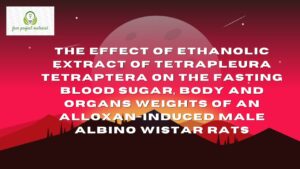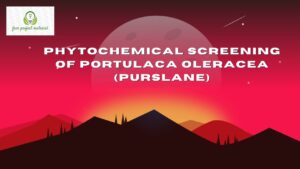ABSTRACT
The leaves of Gnetum africana, Lasianthera africana, Hensia crinata, Telfairia occidentalis, vernonia amygdalina was obtained, air-dried, and then reduced into powdery form. The powder obtained was used to determine the calcium content of each vegetables following standard laboratory procedures. The result revealed the presence of calcium to be higher in Hensia crinata (42.2050.289) followed by Gnetum africana (35.1750.049), Vernonia amygdalina (15.6250.120), Telfairia occidentalis (15.160.071) and Lasianthera africana (11.6950.403). The presence of calcium justifies the medicinal potential of these leafy vegetables in traditional treatment of certain ailments and blood building.
TABLES OF CONTENTS
PAGES
TITLE PAGE – – – – – – – – i
CERTIFICATION – – – – – – – ii
DEDICATION – – – – – – – – iii
ACKNOWLEDGEMENTS – – – – – – iv
ABSTRACT – – – – – – – – v
TABLE OF CONTENT – – – – – – vi-viii
CHAPTER ONE
INTRODUCTION
1.1 Background of the Study – – — – – 1-5
1.2 Aim and Objectives of the Study – – – – 5
1.3 Scope of the Study – – – – – – 6
CHAPTER TWO
LITREATURE REVIEW
2.1 Properties of the Calcium – – – – – 7
2.1.1 Physical Properties – – – – – – 7-8
2.1.2 Chemical Properties – – – – – – 8-11
2.2 Food Sources of Calcium – – – – – 11
2.3 Biological and Pathological Role – – – — 11
2.3.1 Functions of Calcium – – – – – – 11-13
2.3.2 Hormonal Regulation of Bone Formation and Serum Level – 14-15
2.3.3 Kidney Stones – – – – – – – 15
2.3.4 Bone Disease – – – – – – – 16
2.4 Importance of Green Leafy Vegetables – – – 16
2.4.1 Sources of Folate – – – – – – – 16-17
2.4.2 Burns Fat – – – – – – – – 17
2.4.3 Ant-aging – – – – – – — – 18
2.4.5 Improves the Health of the Heart – – – – 18-19
2.4.5 Fight Diabetes – – – – – – – 19-20
2.4.6 Protect Against Toxins – – – — – – 20
2.4.7 Build Enzymes – – – – – – – 20-21
2.5 Calcium Content in Leafy Vegetables – – – 21-22
CHAPTER THREE
MATERIALS AND METHOD
3.1 Materials – – – – – – – – 23
3.2 Methods – – – – – – — – 23
3.2.1 Sample collection and Treatment – – – – 23-24
3.2.2 Digestion of the Sample – – – – – – 24
3.2.3 Determination of Calcium Content – – – – 24-25
CHAPTER FOUR
RESULTS AND DISCUSSION
4.1 Results – – – – – – – – 26
4.2 Discussion – – – – – – – – 27-28
CHAPTER FIVE
CONCLUSION AND RECOMMENDATION
5.1 Conclusion – – – – – – – – 29
5.2 Recommendation – – – – – – – 29
References
CHAPTER ONE
INTRODUCTION
1.1 Background of the Study
Traditional vegetables are important items of diet in many Nigerian homes and they are valuable sources of nutrients especially in rural areas where they contribute substantially to protein, mineral, vitamins, fiber and other nutrients which are usually in short supply in daily diets (Mosha and Gaga, 1999). They have the cheapest and most abundant sources of protein (Fasuyi, 2006) and add flavor, variety, taste, color and aesthetic appeal to diet (Mepba et al., 2002). In Akwa Ibom State, some of the vegetables that are found include: Heinsia crinita, Cucurbita maxima, Lasianthera africana, Pterocarpus mildbraedii, Solanum nodiflorum, Gnetum africanum, Telfairia occidentalis, Talinum triangulare, Occimum gratissimum, Vernonia amygdalina, Cannabis sativa, Abelmoschus esculentus, Curcubita pepo etc. In Nigeria where the daily diet is dominated by starchy staples, these indigenous leafy vegetables are the most readily available sources of important micro-nutrients such as: vitamins, especially the pro-vitamin A or β-carotene (Martin, 1998) as well as essential amino acids and mineral elements. These vegetables are important commodities for poor households because their prices are relatively affordable compared with other food items. Scarcity of vegetable in the diet is a major cause of vitamin, A deficiency, which causes blindness and even death in young children throughout the Arid and Semi-Arid areas of Africa (Okigbo, 1986).
Leafy vegetables are important part of diet in many Nigerian homes as they add varieties to the menu. Edible leaves from vegetables plants are eaten as supporting food or main dishes (Hanif et al., 2006). Most of the vegetables in abundance shortly after rainy season become scarce during the dry season. They are the cheapest and the most accessible source of proteins, vitamins, minerals, fibre and essential amino acids (Okafor, 1983; Fasuiji, 2006).
More importantly, leafy vegetables are highly beneficial for maintenance of health and prevention of diseases. The world health organization and the Food and Agricultural Organization (FAO) of the United Nations advocates a minimum intake of 400 g of fruits and vegetables per day for adults to prevent chronic diseases like cancer, heart ailments, diabetes and micro nutrients deficiencies. It recommends that people should eat at least five varieties of fruits and vegetables every day. Supporting this point, Hanif et al. (2006) related that vegetables contain valuable sources of food ingredients that can be utilized to build up the body and improve health successfully. Vegetables also maintain the alkaline reserve of the human body. There are different types of vegetables and each group contributes in its own way to the diet (Robinson, 1990). Hence, they play prominent roles in the traditional food habits of many cultural groups. Various ethnic groups consume varieties of different indigenous types of vegetables for different reasons as some consider them to be medicinal and blood building. As stated by Mensah et al. (2008), addition of a small amount of building vegetables like spinach and water leaf in food intake can prevent the occurrence of diseases such as river blindness.
In Nigeria, leafy vegetables are frequently processed in order to make them edible. In addition, they are processed to prevent them from spoilage by both traditional and modern methods. Some predominant methods include but not limited to the following; sun-drying, air-drying, blanching, steaming, boiling, reheating and freezing.
Some calcium compounds were known to the ancients, though their chemistry was unknown until the seventeenth century. Pure calcium was isolated in 1808 via electrolysis of its oxide by Humphry Davy, who named the element. Calcium compounds are widely used in many industries: in foods and pharmaceuticals for calcium supplementation, in the paper industry as bleaches, as components in cement and electrical insulators, and in the manufacture of soaps. On the other hand, the metal in pure form has few applications due to its high reactivity; still, in small quantities it is often used as an alloying component in steelmaking, and sometimes, as a calcium–lead alloy, in making automotive batteries (Linus Pauling Institute, 2017).
Calcium is the most abundant metal and the fifth-most abundant element in the human body (Linus Pauling Institute, 2017). As an electrolytes, ionic calcium play a vital role in the physiological and biochemical processes of organisms and cells: in signal transduction pathways where they act as a second messenger; in neurotransmitter release from neurons; in contraction of all muscle cell types; as cofactors in many enzymes; and in fertilization (Linus Pauling Institute, 2017). Calcium ions outside cells are important for maintaining the potential difference across excitable cell membranes, protein synthesis, and bone formation (National Institute of Health, 2019).
1.2 Aim
The aim of this study was to carry out the comparative analysis of calcium contents of some leafy vegetables used for soup meals in Akwa Ibom Stae.
1.2.2 Objectives
The objectives of the Study are;
- To determine the Calcium in five leafy vegetables used for soup meals in Akwa Ibom State.
- To compare the values of Calcium in the different leafy vegetables.
- To discuss the results and draw conclusion.
1.3 Scope of the Study
The scope of the study covers only the analysis of the calcium contents of some leafy vegetables namely: Lasianthera Africana, Heinsia crinata, Gnetum Africana, Venonia amydalina, Telferial occidentalis. Used for soup meal in Akwa Ibom State Polytechnic.



